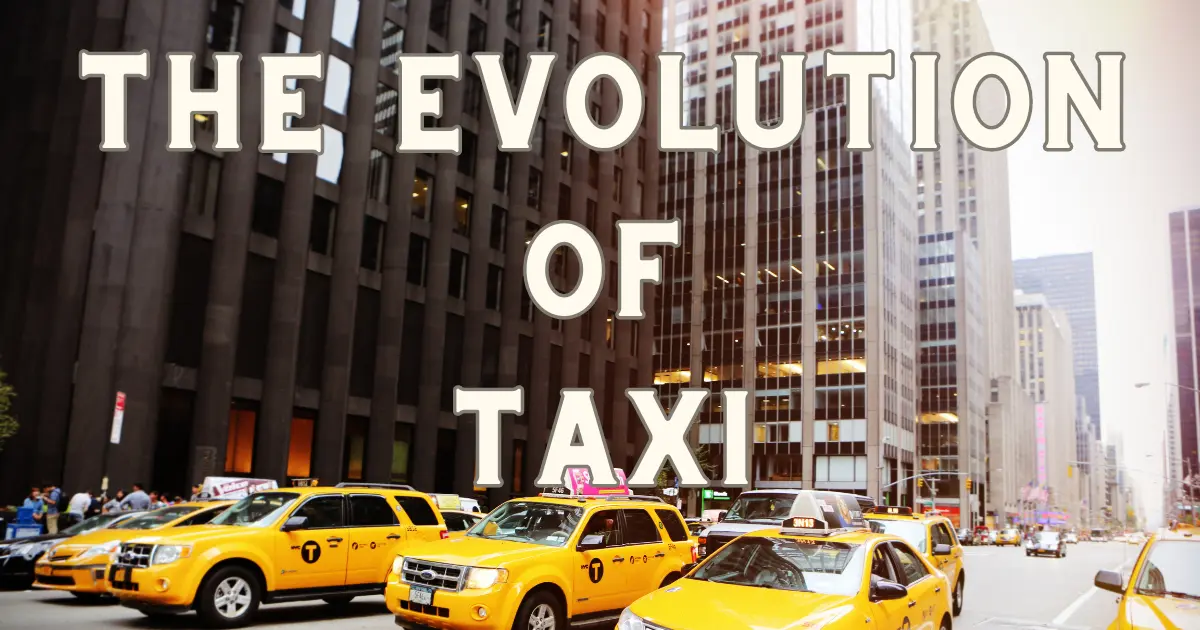From Horse-Drawn Carriages to Autonomous Vehicles
Buckle up and prepare for a journey through time as we explore how taxis have evolved from humble horse-drawn carriages to cutting-edge autonomous vehicles that can navigate city streets without human intervention. In this era where technology seemingly advances at lightning speed, it’s fascinating to delve into how transportation has transformed over centuries to meet our growing needs and expectations. As we embark on this exploration, be prepared for surprises along the way – quirky anecdotes, revolutionary inventions, and perhaps even some controversy – all revealing the captivating story behind one of humanity’s most enduring modes of transportation: the taxi.
The history and significance of taxis
Taxis have a long and storied history that spans across centuries. The concept of offering transportation services for hire can be traced back to ancient Rome, where horse-drawn carriages were popular modes of transportation. However, it was not until the 17th century that taxis as we know them today began to emerge. In 1635, the first documented taxi service was established in Paris, using horse-drawn carriages operated by drivers known as taxis (French for taximeter). This early version of the taxi allowed passengers to easily calculate their fare based on the distance traveled.
The significance of taxis goes beyond being a convenient mode of transportation in urban areas. Taxis have served as symbols of innovation and progress throughout history. In the late 19th century, electric taxis gained popularity in major cities like New York and London. These electric cabs were seen as groundbreaking advancements at a time when gasoline-powered vehicles were still relatively new. Moreover, taxis have often played important roles during pivotal historical moments – from transporting soldiers during wars to serving as symbols of resistance against oppressive regimes. They have proven themselves to be versatile vehicles that adapt and evolve with changing times.
Today, while ridesharing services like Uber and Lyft have disrupted the traditional taxi industry, taxis still retain their cultural significance and appeal to many people around the world. Taxis are more than just a means to get from point A to point B; they represent an iconic part of our daily lives and collective memory. From yellow
The early days: Horse-drawn carriages
Long before the invention of the automobile, horse-drawn carriages ruled the roads. These elegant and sturdy vehicles were not only a means of transportation but also a symbol of wealth and status. In the early days, horse-drawn carriages were powered by horses that were specially bred and trained for this purpose.
The creation of these carriages can be traced back to ancient times when civilizations like the Egyptians and Greeks used them for various purposes. Over time, different styles of carriages emerged, each designed for a specific function or social class. From simple carts used by peasants to ornate coaches used by royalty, horse-drawn carriages became an integral part of society.
Despite their popularity, these early forms of transportation had their drawbacks. The speed at which a carriage could travel was limited by the endurance and strength of the horses pulling it. Additionally, maintaining a carriage required constant attention – from cleaning and polishing to harnessing and feeding the horses.
However, despite these challenges, horse-drawn carriages played a crucial role in shaping our modern transportation systems. They provided people with an opportunity to travel comfortably over long distances while also serving as beautiful works of art that showcased craftsmanship and luxury. As we reflect on these early days, it is clear that horse-drawn carriages paved the way for future advancements in technology and ultimately led to the birth of automobiles as we know them today.
The rise of motorized taxis
The rise of motorized taxis has undoubtedly transformed the way we commute in urban areas. With the emergence of ride-hailing platforms like Uber and Haywards Heath Cabs, traditional taxi services are facing intense competition for their customer base. What was once a common sight on city streets – the yellow cab – is now often overshadowed by cars displaying distinct ride-hailing logos.
One of the key factors contributing to the popularity and success of motorized taxis is convenience. Through mobile applications, passengers can effortlessly request a ride from anywhere at any time, eliminating the need to search for available cabs or wait on busy street corners. This newfound ease has attracted commuters seeking quick and reliable transportation options.
Additionally, motorized taxis have revolutionized accessibility for individuals with disabilities. Ridesharing companies have introduced inclusive features like wheelchair-accessible vehicles and special assistance options, allowing those previously limited in their transportation choices to enjoy greater independence and freedom. By embracing this technological advancement, cities are taking significant steps towards inclusivity and ensuring that everyone can benefit from efficient public transportation solutions.
The impact of technology on taxis
The emergence of ride-hailing platforms like Uber and Haywards Heath Cabs has undoubtedly transformed the taxi industry. The convenience and accessibility provided by these technological innovations have revolutionized the way people travel and reshaped the traditional concept of taxis. With just a few taps on their smartphones, users can now request rides, track drivers in real-time, and even split fares with friends, all within seconds. This has not only improved the overall customer experience but also challenged traditional taxi companies to adapt or risk being left behind.
One significant impact that technology has had on taxis is leveling the playing field for both drivers and passengers. In the past, hailing a cab often meant waiting by the roadside or relying on expensive dispatch services. However, with smartphone apps becoming an integral part of our daily lives, ride-hailing services have made transportation more accessible to a wider audience. Whether in a busy city center or a remote town, individuals can now access reliable transportation options with ease.
Furthermore, technology has facilitated greater transparency and accountability within the taxi industry. Traditional taxis were notorious for hidden fees, long routes taken to inflate fares, or even instances of rude behavior from drivers. Ride-hailing platforms have addressed these issues by implementing features such as upfront pricing and driver ratings/reviews systems that provide valuable information about previous passengers’ experiences. As a result, both drivers and passengers are incentivized to maintain high standards of service quality since their reputations are at stake.
Overall, it is clear that technology has had a profound impact on taxis by improving accessibility
The emergence of ride-hailing services
The emergence of ride-hailing services has completely revolutionized the way we travel in cities and beyond. With just a few taps on our smartphones, we can now summon a car to pick us up from anywhere, eliminating the need for traditional taxis or waiting for public transportation. This convenience and ease of use have made ride-hailing services like Uber and Haywards Heath Cabs increasingly popular among urban dwellers.
One of the key factors driving the growth of ride-hailing services is the rise of peer-to-peer platforms that allow individuals to monetize their own vehicles. This not only provides an additional source of income for car owners but also leads to a more efficient use of existing resources. With more people opting to share rides instead of driving their own cars, congestion on roads can be reduced and carbon emissions can be minimized.
Despite their popularity, ride-hailing services are not without controversy. Critics argue that these companies exploit drivers by offering low wages and few employment benefits. Additionally, concerns about passenger safety have been raised after several incidents were reported involving unauthorized drivers picking up passengers using fake credentials. These issues underscore important regulatory challenges that need to be addressed as ride-hailing continues to gain traction worldwide.
In conclusion, ride-hailing services have emerged as a game-changer in urban transportation by providing a convenient alternative to traditional taxis or public transit systems. However, challenges related to driver compensation and passenger safety need careful attention from regulators going forward. As technology continues to advance and consumer preferences evolve, it will be interesting to see how these services
Towards autonomous taxi fleets
The rise of autonomous vehicles has brought forth much anticipation and excitement, particularly in the realm of transportation. One area that holds significant promise is the development of autonomous taxi fleets. With major companies like Uber and Haywards Heath Cabs already testing self-driving cars, it’s clear that this revolutionary transformation is just around the corner.
One key advantage of autonomous taxi fleets is their potential to significantly reduce traffic congestion. These vehicles can communicate with each other in real-time, optimizing routes and minimizing unnecessary stops and slowdowns. As a result, users can expect shorter travel times and more efficient use of road space, ultimately leading to smoother traffic flow in urban areas.
Furthermore, autonomous taxi fleets have the potential to revolutionize public transportation by bridging gaps in service coverage. Traditional transit systems often struggle to provide comprehensive access to all areas within a city or town. However, with self-driving taxis that are always available on-demand, users could easily reach even the most remote areas at any time of day or night.
In addition to these advantages, widespread adoption of autonomous taxi fleets could also lead to a reduction in vehicle ownership rates. Many individuals who currently own personal vehicles may find it more convenient and cost-effective to rely on shared autonomous taxis instead. This shift would allow for better utilization of existing resources and result in fewer cars on the road overall.
In conclusion, towards fully embracing autonomy in taxi services presents numerous advantages for our future transportation systems – from reduced congestion and improved traffic flow to increased accessibility for all individuals regardless of their location or economic status.
Conclusion: The future of taxi transportation
In conclusion, the future of taxi transportation appears to be shifting towards autonomous vehicles. Companies like Uber and Haywards Heath Cabs are already investing heavily in self-driving technology and conducting trials in several cities. The potential benefits of autonomous taxis are vast – they eliminate the need for human drivers, which eliminates human error and increases safety on the roads. Additionally, they have the potential to reduce traffic congestion and increase efficiency in terms of fuel usage.
However, there are still numerous challenges that need to be overcome before autonomous taxis become a reality. Legal and regulatory frameworks must be established to govern their operation, as well as guidelines for resolving liability issues in cases of accidents or technical failures. Moreover, public acceptance and trust in self-driving technology will also play a crucial role in determining the success of these services.
Another key factor influencing the future of taxi transportation is the rise of ride-sharing platforms. With many consumers opting for shared rides instead of owning their own cars, it is likely that this trend will continue to grow. This could lead to optimized routes and decreased costs for passengers, making ride-sharing an attractive option for many urban dwellers.
Overall, while there may be obstacles along the way, it seems clear that both autonomous vehicles and ride-sharing platforms will shape the future of taxi transportation. As technology advances and society becomes more open to innovative solutions, we can expect to see major changes in how we get around our cities in years to come.

